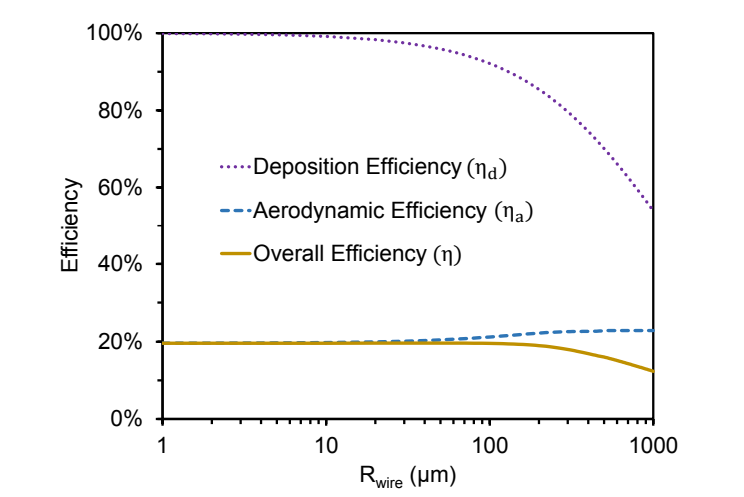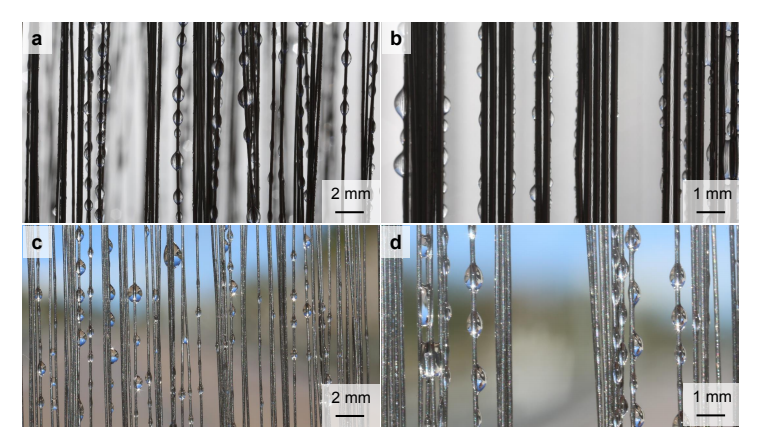3D Printed Parts for Fog Harps: Water Harvesting Inspired by Redwood Trees
Weiwei Shi recently submitted a dissertation, ‘Tree Inspired Water Harvesting,’ to the faculty of the Virginia Polytechnic Institute and State University. In this study, Shi and a research team developed unique devices inspired by redwood trees, meant to efficiently harvest water.
With the use of fog harps (devices that look like harps but collect moisture droplets from fog), floating leaves, and synthetic trees, the researchers aimed to refine efficiency in aerodynamics, deposition, and sliding for water harvesting. The fog harps were made of a vertical set of wires, similar to redwood trees, able to manipulate fog droplets easily, whether ‘capturing’ or ‘shedding.’ Such devices can be used in areas with water shortages and little rainfall, set up to harvest condensation from fog. Typical areas where these might be used include Chile, Peru, South Africa.

(a) Schematic of captured fog droplets on a fog harp. Photos of (b) the singlelayer fog harp and (c) control case of a square-mesh netting. (d) Fog towers generated heavy fog, under which the harvesters were placed.
“Water shortage is a global problem. More than four billion people do not have enough water for at least one month of the year; five hundred million of them lack enough water throughout the entire year. Fog harvesting is a helpful technique to collect water from fog,” stated Shi. “In California’s coastal redwood forests, approximately 34% of the annual water input was from fog drip off the redwoods themselves.”
Synthetic trees were created with nanoporous disks representing leaves and tubes acting as xylem conduits, all in an effort to re-create the redwood, and its expeditious transpiration process. Harps consisting of micrometric wires were able to harvest fog droplets without clogging; in fact, they offered a ‘three-fold enhancement’ in comparison to the use of traditional mesh netting.
Stainless steel nuts placed on the threaded rods of the new harps provided extra space between the top and bottom of the frame, with two 3D printed parts snapped on the top and bottom halves, sprayed with Rust-Oleum. Droplets fell into a reservoir for collecting water, with the upper piece of the harp directing fog away.

Summary of the wire material, wire diameter (D), ratio of the center-to-center pitch between wires to the wire diameter (P/D), shade coefficient (SC), and Stokes number (St) for each of the harps (H1–H3) and meshes (M1–M3) used in this study
“For the classical mesh design, the mid-sized mesh (M2) harvested about 1.7 times more water compared to the fine mesh (M1) and 1.5 times more than the coarse mesh (M3). This is due to the aforementioned dual constraints of clogging for fine meshes and inefficient fog capture for coarse meshes,” explained Shi.
“The harp’s ability to avoid clogging even at small scales is due to the reduced pinning force of droplets shedding parallel to the axis of the wires, compared to a mesh where orthogonal wires impede the contact line. This is somewhat analogous to the well-known case of droplets easily sliding parallel to superhydrophobic grooves, as both cases exhibit only liquid-air interfaces between the axial features and avoid any obstacles orthogonal to the receding contact line.”

Schematic of the “fog harp” design, where vertically oriented wires of diameter D and pitch P are held under tension within a frame.

A theoretical model for the aerodynamic efficiency (⌘a, Equation 2.1), droplet deposition efficiency (⌘d, Equation 2.4), and total efficiency (⌘ = ⌘a⌘d) of fog harps as a function of wire radius for a fixed shade coefficient (SC = 0.5). In the absence of appreciable clogging, ⌘ increases by a factor of 1.7 as the wire radius shrinks from Rwire ⇠ 1 mm to Rwire⇠ 100 µm. A performance ceiling is then reached with no significant increase in ⌘ with further shrinking of the wires, due to ⌘d nearing 100% efficiency by Rwire⇠ 100 µm
“The floating leaf was tested within an environmental chamber with controlled ambient humidities, the synthetic stomata optionally atop the floating leaf. The leaf can “transpire” stably in a wide variety of ambient humidities, even without the stomata, because the water menisci would partially retreat into nanopores to choke the vapor inside, thus increasing the local relative humidity right above the menisci,” stated Shi.
The synthetic tree will also be accompanied by a ‘tree on a chip,’ along with a glass roof to be bonded over the face of microchannels.
“Further, a resistive heat source will be thermally lumped to this tree-on-a-chip to dramatically vary the transpiration rate, and by extension, the magnitude of the negative Laplace pressure within the system,” concluded Shi.
Water shortages continue to plague developing countries, and researchers around the world have created numerous 3D printed devices, from those meant to test potability, purification, and even filter saltwater.
What do you think of this news? Let us know your thoughts! Join the discussion of this and other 3D printing topics at 3DPrintBoard.com.

Tangling issues on (a,b) the double-layer harp and (c,d) the single-layer harp. Wires tangled together by the surface tension of captured water droplets on wetted harps.
Subscribe to Our Email Newsletter
Stay up-to-date on all the latest news from the 3D printing industry and receive information and offers from third party vendors.
Print Services
You May Also Like
3D Printing Grows to $15.9B in 2024 Amid Shifting Industry Dynamics
The global additive manufacturing (AM) market reached $15.9 billion in calendar year 2024, according to “Q4 2024 3DP/AM Market Data and Forecast” from Additive Manufacturing Research (AM Research). Despite a...
3DPOD 247: LJ Holmes, Executive Director for the Center of Advanced Manufacturing and Materials at Harrisburg University
Executive Director for the Center of Advanced Manufacturing and Materials at Harrisburg University, Larry “LJ” Holmes is a pioneer in applying additive manufacturing to defense and other critical sectors. Part...
Thai Startup OsseoLabs to Cut Surgery Time with 3D Printed Magnesium Implants
A patient undergoing mandibular reconstructive surgery typically faces two separate operations: one to place a custom-fit titanium plate and another month later to remove it. But what if that second...
Japanese Advanced Manufacturing Capabilities Grow in Europe with Sodick’s Purchase of Prima Additive
The global economy is currently undergoing a reshuffling in terms of what gets manufactured where. In large part, this trend is being driven by new geopolitical alliances and the need...

























